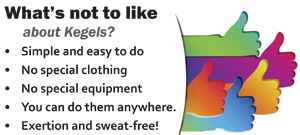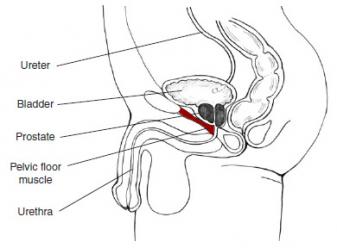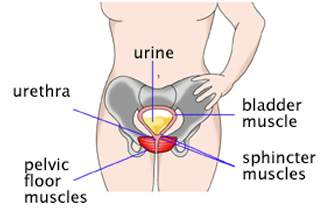Kegel Exercises
Do you experience bladder leakage? Learn how to tone your pelvic floor muscles to stay in control of your bladder.
 Who?
Who?
Although Kegel exercises are most familiar to women experiencing urinary leakage after childbirth, these exercises are an equally effective tool to help men improve bladder control. For many men, doing Kegel exercises has the added benefit of improving erectile dysfunction and premature ejaculation.
Why?
Your pelvic floor muscles support the rectum, urethra, bladder and other organs in the pelvis. Kegel exercises strengthen these muscles and help keep the bladder closed. Toning these muscles regularly can help you control bladder leakage and lower your risk of hemorrhoids.
How?

A man's pelvic floor muscles and organs
The first step is to find the right muscles. The illustrations on this page identify the pelvic floor muscles and the organs they support. To help identify your own pelvic floor muscles, imagine that you are trying to stop yourself from passing gas. Squeeze the muscles you would use. If you sense a “pulling” feeling, those are the right muscles for pelvic exercises.

A woman's pelvic floor muscles and organs
As you are learning, do your Kegels lying down so your muscles do not need to work against gravity. Try to isolate and squeeze just the pelvic floor muscles without tightening your stomach, leg or buttocks at the same time. To do the exercise, squeeze or pull in the pelvic muscles; hold for a count of 5 and relax for a count of 5. Your daily goal should be three sessions of 10 Kegels, each held to the count of 5.
As your muscles get stronger, begin doing your exercises while sitting and standing, too. This will put more weight on the muscles, boosting your workout and improving your control. Practicing all three positions every day makes the muscles strongest.
Where?
 Until you are comfortable doing Kegel exercises, choose a quiet spot to practice, like your bathroom or your bedroom, so you can concentrate. Once you know how, you can do these exercises anywhere― at your desk, in the car, waiting in line, at the kitchen counter, etc. To help ensure that you will be consistent, make it a habit to do your Kegels in a particular place or during a certain activity, such as brushing your teeth, doing the dishes or driving to work.
Until you are comfortable doing Kegel exercises, choose a quiet spot to practice, like your bathroom or your bedroom, so you can concentrate. Once you know how, you can do these exercises anywhere― at your desk, in the car, waiting in line, at the kitchen counter, etc. To help ensure that you will be consistent, make it a habit to do your Kegels in a particular place or during a certain activity, such as brushing your teeth, doing the dishes or driving to work.
For how long?
Be patient. Do not give up. It may take three to six weeks for your bladder control to improve, although most people notice an improvement after a few weeks.
 Your daily goal should be three sessions of 10 Kegels, each held to the count of 5. Like any type of exercise, Kegel exercises only work as long as you do them. Once you stop, the muscles will become weak again and your bladder problems might return to their previous level.
Your daily goal should be three sessions of 10 Kegels, each held to the count of 5. Like any type of exercise, Kegel exercises only work as long as you do them. Once you stop, the muscles will become weak again and your bladder problems might return to their previous level.
Make doing your Kegels a lifetime habit, and stay motivated by focusing on the improvements you experience in your bladder control.